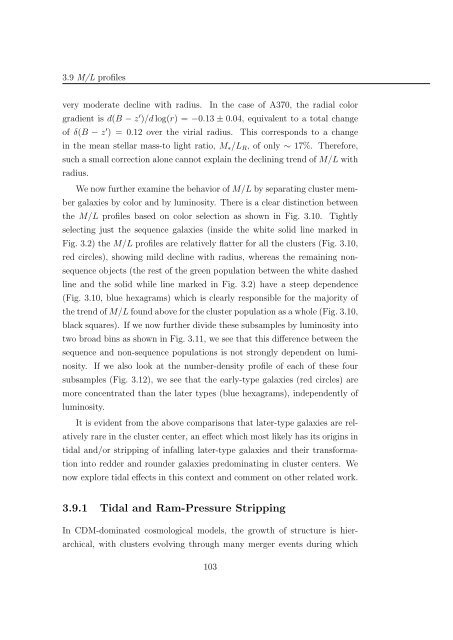Mass and Light distributions in Clusters of Galaxies - Henry A ...
Mass and Light distributions in Clusters of Galaxies - Henry A ...
Mass and Light distributions in Clusters of Galaxies - Henry A ...
You also want an ePaper? Increase the reach of your titles
YUMPU automatically turns print PDFs into web optimized ePapers that Google loves.
3.9 M/L pr<strong>of</strong>iles<br />
very moderate decl<strong>in</strong>e with radius. In the case <strong>of</strong> A370, the radial color<br />
gradient is d(B − z ′ )/d log(r) = −0.13 ± 0.04, equivalent to a total change<br />
<strong>of</strong> δ(B − z ′ ) = 0.12 over the virial radius. This corresponds to a change<br />
<strong>in</strong> the mean stellar mass-to light ratio, M ∗ /L R , <strong>of</strong> only ∼ 17%. Therefore,<br />
such a small correction alone cannot expla<strong>in</strong> the decl<strong>in</strong><strong>in</strong>g trend <strong>of</strong> M/L with<br />
radius.<br />
We now further exam<strong>in</strong>e the behavior <strong>of</strong> M/L by separat<strong>in</strong>g cluster member<br />
galaxies by color <strong>and</strong> by lum<strong>in</strong>osity. There is a clear dist<strong>in</strong>ction between<br />
the M/L pr<strong>of</strong>iles based on color selection as shown <strong>in</strong> Fig. 3.10. Tightly<br />
select<strong>in</strong>g just the sequence galaxies (<strong>in</strong>side the white solid l<strong>in</strong>e marked <strong>in</strong><br />
Fig. 3.2) the M/L pr<strong>of</strong>iles are relatively flatter for all the clusters (Fig. 3.10,<br />
red circles), show<strong>in</strong>g mild decl<strong>in</strong>e with radius, whereas the rema<strong>in</strong><strong>in</strong>g nonsequence<br />
objects (the rest <strong>of</strong> the green population between the white dashed<br />
l<strong>in</strong>e <strong>and</strong> the solid while l<strong>in</strong>e marked <strong>in</strong> Fig. 3.2) have a steep dependence<br />
(Fig. 3.10, blue hexagrams) which is clearly responsible for the majority <strong>of</strong><br />
the trend <strong>of</strong> M/L found above for the cluster population as a whole (Fig. 3.10,<br />
black squares). If we now further divide these subsamples by lum<strong>in</strong>osity <strong>in</strong>to<br />
two broad b<strong>in</strong>s as shown <strong>in</strong> Fig. 3.11, we see that this difference between the<br />
sequence <strong>and</strong> non-sequence populations is not strongly dependent on lum<strong>in</strong>osity.<br />
If we also look at the number-density pr<strong>of</strong>ile <strong>of</strong> each <strong>of</strong> these four<br />
subsamples (Fig. 3.12), we see that the early-type galaxies (red circles) are<br />
more concentrated than the later types (blue hexagrams), <strong>in</strong>dependently <strong>of</strong><br />
lum<strong>in</strong>osity.<br />
It is evident from the above comparisons that later-type galaxies are relatively<br />
rare <strong>in</strong> the cluster center, an effect which most likely has its orig<strong>in</strong>s <strong>in</strong><br />
tidal <strong>and</strong>/or stripp<strong>in</strong>g <strong>of</strong> <strong>in</strong>fall<strong>in</strong>g later-type galaxies <strong>and</strong> their transformation<br />
<strong>in</strong>to redder <strong>and</strong> rounder galaxies predom<strong>in</strong>at<strong>in</strong>g <strong>in</strong> cluster centers. We<br />
now explore tidal effects <strong>in</strong> this context <strong>and</strong> comment on other related work.<br />
3.9.1 Tidal <strong>and</strong> Ram-Pressure Stripp<strong>in</strong>g<br />
In CDM-dom<strong>in</strong>ated cosmological models, the growth <strong>of</strong> structure is hierarchical,<br />
with clusters evolv<strong>in</strong>g through many merger events dur<strong>in</strong>g which<br />
103
















